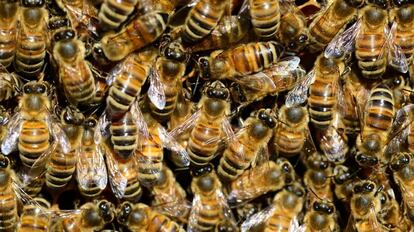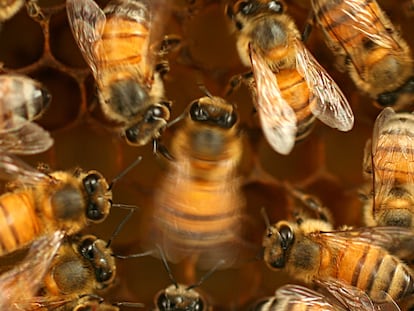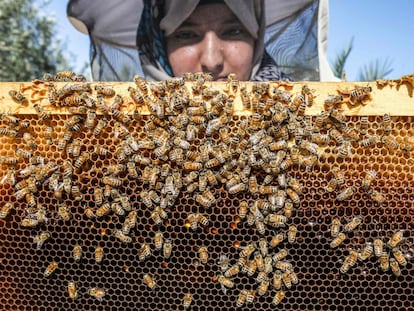The bee effect: a small change in a biological network can lead to catastrophe
A study shows how disturbances can profoundly affect an ecosystem no matter how insignificant or beneficial they may seem

An equilibrium becomes unstable when a small disturbance causes a body to move from its original position, impacting the entire system. This principle is fundamental in aeronautics and also observed in nature. Previously, studies focused on the isolated effects of disturbances on ecosystem elements. However, ecosystems function as complex networks, resembling a fine woolen weave. Disturbing a single thread can have a ripple effect on the entire fabric, potentially leading to catastrophic consequences. A study published in Nature and co-authored by Jordi Bascompte, winner of the Ramón Margalef Ecology Award and researcher at the University of Zurich (Switzerland), demonstrates how interactions generate direct and indirect effects that influence the fitness of coevolving species in natural networks. For instance, the introduction of the honey bee into an environment where it becomes invasive can dramatically disrupt the entire system.
According to the Nature study, species fitness refers to the survival and reproductive abilities of organisms. It is considered a fundamental biological factor, influenced by ecological interactions that range from antagonistic to mutualistic. These interactions have played a major role in the generation and preservation of Earth’s biodiversity. “Through interactions, we gain insights into how communities function, how many ecosystem services are articulated and how the biodiversity architecture is built,” said Bascompte.
The chain reaction or ripple effect has been extensively studied in the context of two links and isolated interactions. For example, when years of interaction results in a butterfly’s proboscis equaling the length of a plant’s floral tube. However, focusing solely on this can overlook other direct or indirect effects on the overall natural network. “Evolutionary biology has regrettably focused on extreme cases of maximum specialization, which are the ones that make the headlines,” said Bascompte.
The new study examined 186 networks using analytical methods and numerical simulations. It highlights the direct and indirect impacts that disrupt the fitness of coevolving species in these networks. These impacts can go unnoticed, be unintentionally catastrophic, or have delayed consequences that become irreversible. None of them are entirely harmless. Understanding the fragile balances in nature is crucial for prevention and action.
When honey bees become invasive
According to the study, peripheral species in a mutualistic network endure more indirect effects and face greater declines in fitness compared to central species — the ones directly interacting with many other species. The researchers also found similar patterns in a real-world case study of a honey bee invasion. As honey bees became integral to the networks as a central species, the indirect effects on other species increased, leading to fitness declines. This study highlights how these indirect effects can shape the adaptive landscape of species-rich mutualistic communities.
“This theory of biological efficiency enables us to map the changes in each of the networks and see which species benefit and which ones don’t,” said Bascompte. Some ecosystems, such as coral reefs and tropical forests, rely heavily on mutually beneficial relationships. According to the study, mutualistic interactions, by definition, increase the fitness of interacting individuals and are reinforced by reciprocal evolutionary changes.
However, this benefit can have indirect effects on the ability of other species to survive, particularly those that do not coevolve in the same manner. The study finds that when a species has a greater indirect impact on the evolution of another species, the latter’s fitness declines.
“We shouldn’t just think about humans and the biosphere separately, but rather of humans as a part of the biosphere, forming connections within those networks.”Biologist Jordi Bascompte, University of Zurich
Human activity disrupts ecological interactions and has extraordinary effects. It leads to a reorganization of direct and indirect relationships, altering the outcome of coevolution and impacting species fitness, according to the Nature study. “We shouldn’t just think about humans and the biosphere separately, but rather of humans as a part of the biosphere, forming connections within those networks,” warns Bascompte.
The study simulated the effects of introducing the European honey bee (Apis mellifera) into an environment where it is not the central species in pollination networks, demonstrating that turning it into an invader can substantially affect the fitness of native species and reshape their adaptive landscapes.
The same experiment also recognizes that affected species can develop new mutualistic relationships. However, the researchers caution that their evidence suggests this is uncommon, especially when invasive species are present in high densities. The study shows how and why indirect effects can govern the adaptive landscape of species-rich mutualistic assemblages.
Research applications
Bascompte believes that these findings are of extraordinary relevance when it comes to ecosystem restoration. “It doesn’t make sense, for instance, to reintroduce species that rely on other generalist species that are not currently part of the community.”
Another opportunity for application of this research is in the recovery of already extinct species. “We often have a tendency to think in a linear and simplistic manner,” said Bascompte. “However, over the past few hundred years, species have evolved and communities have transitioned into different states. Sometimes, well-intentioned actions can have unintended and disastrous effects. Understanding these consequences can be challenging due to the complex network of interactions and incidents within communities. This complexity makes it difficult to make accurate predictions.”
Theoretical models of interaction networks can also be used to predict the behavior of an ecological system and identify points of no return. “It’s kind of like watching a movie replay of history, where we can fast-forward through gradual extinctions, see their consequences, and witness the point of collapse of the whole network,” he said.
“Ecological systems,” clarifies Bascompte, “do not necessarily function in a linear manner. If 20% of the habitat is destroyed and five species are lost, one might mistakenly think that destroying 40% would lead to the extinction of 10 species. That’s not the case. Sometimes, nothing seems to happen because systems are able to absorb the disturbance. But if conditions worsen, ecological systems lose that resilience. A threshold is reached where destroying an additional 3% of habitat could be catastrophic, causing the system to collapse abruptly. Our research enables us to predict the proximity of these points of no return.”
A different study published in Plos One also found that the harm leading to biodiversity loss is not immediately obvious, and calls this an “extinction debt.” The article states that research mainly concentrates on fast habitat and species losses. However, there is a gradual extinction that occurs following the initial rapid loss, and it subsequently increases exponentially.
Bascompte explained that certain life forms require a critical network size to thrive in an ecosystem. Once established, these organisms function automatically. Studying network properties helps identify the minimal intervention needed for their operation. He thinks it’s important to have a basic grasp of direct and indirect effects in a network, as it applies to various areas of life where interaction matters. “Sociologists have actually measured how much a person’s voting intention can be influenced by people they’ve never directly interacted with, but rather through a shared friend,” said Bascompte. Just as these learnings can be applied to economics, labor, international relations and social communication, they also resonate with various communities in our environment. In the grand tapestry of life, we are all intricately woven together in a complex network that shapes our very existence.
Sign up for our weekly newsletter to get more English-language news coverage from EL PAÍS USA Edition
Tu suscripción se está usando en otro dispositivo
¿Quieres añadir otro usuario a tu suscripción?
Si continúas leyendo en este dispositivo, no se podrá leer en el otro.
FlechaTu suscripción se está usando en otro dispositivo y solo puedes acceder a EL PAÍS desde un dispositivo a la vez.
Si quieres compartir tu cuenta, cambia tu suscripción a la modalidad Premium, así podrás añadir otro usuario. Cada uno accederá con su propia cuenta de email, lo que os permitirá personalizar vuestra experiencia en EL PAÍS.
¿Tienes una suscripción de empresa? Accede aquí para contratar más cuentas.
En el caso de no saber quién está usando tu cuenta, te recomendamos cambiar tu contraseña aquí.
Si decides continuar compartiendo tu cuenta, este mensaje se mostrará en tu dispositivo y en el de la otra persona que está usando tu cuenta de forma indefinida, afectando a tu experiencia de lectura. Puedes consultar aquí los términos y condiciones de la suscripción digital.











































